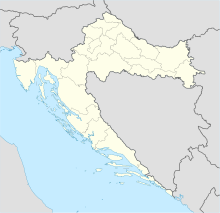Gornja Rijeka concentration camp
The KZ Gornja Rijeka was during the Second World War, a concentration camp of the Croatian Ustasha in Gornja Rijeka at Krizevci in the recently founded fascist Independent State of Croatia (NDH). It was designed in 1942 as a special concentration camp for children up to the age of 16, especially for Serbian , but also Jewish children, and was only made possible by the invasion of German and Italian troops in Yugoslavia in 1941. However, some Serb women were also interned.
history
Coordinates: 46 ° 1 ′ 0 ″ N , 16 ° 33 ′ 0 ″ E
On November 25, 1941, the Poglavnik ( Croatian : Führer ) Ante Pavelić issued the Law Order No. CDXXIX-2101-Z-1941, which was signed by the Minister of Justice and Religion Mirko Puk . It allowed people who were unpopular to be forcibly sent to concentration camps. A few months earlier, construction of the central warehouse began. On July 12, 1942, three children's camps were completed in the Jasenovac concentration camp complex . These were the Sisak concentration camps , the Jastrebarsko concentration camps and the Gornja Rijeka concentration camp, the smallest of the three, built in an abandoned castle . Vjekoslav Luburić , known as Maks , a member of the Ustaše , had supreme authority over all camps in the Jasenovac complex and thus also over Gornja Rijeka . The power of attorney over the camps was given to Luburić by Pavelić.
The Gornja Rijeka concentration camp was founded as Djecji dom za izbeglicku Djecu (“Children's home for refugee children”). On the advice of the German allies and on the basis of public opinion, the Ustaša leadership allowed the removal of some Serb and Jewish children who had been with their parents in the Jasenovac concentration camp and founded children's homes for them. In order to give the actions a semblance of humanity , the Red Cross and the Ministarstvo za udružbu , the social welfare department of the Ministry of Social Affairs, were entrusted with the maintenance of the camps. The first child transport reached Gornja Rijeka on June 24, 1942. In the next few days, more children from Jasenovac and the Stara Gradiška concentration camp were deported to Gornja Rijeka . The camp management consisted of the Ustaška mladež , the Ustasha youth. Typhus ruled the camp from the start . The epidemic could not be stopped, so the camp was disbanded in mid-August. With the help of the Red Cross, 50 children were transferred to the hospitals in Zagreb , and 150 more children to the Jasterbarsko concentration camp. Around 140 children died in the camp. According to the humanist Diana Budisavljević , more than half of the 400 children housed in the camp are said to have died.
Web links
- Jasenovac - Research Institute Quarterly: The JRI is fighting for Property Restitution for Ustashe's Victims (PDF document in English) (626 kB)
- The Center for Peace in the Balkans: The Heirs to Kindness in Croatia (eyewitness account in English)
Individual evidence
- ↑ a b c d e Wolfgang Benz , Barbara Distel (ed.): The place of terror . History of the National Socialist Concentration Camps. Volume 9: Labor education camps, ghettos, youth protection camps, police detention camps, special camps, gypsy camps, forced labor camps. CH Beck, Munich 2009, ISBN 978-3-406-57238-8 , pp. 316-317.
- ↑ a b c d e Jasenovac - Research Institute Quarterly: The JRI is fighting for Property Restitution for Ustashe's Victims. Vol I, No. 3, New York - Winter / Spring 2006, p. 12.
